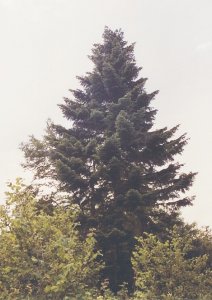Silver fir (Abies alba)
| Occurrence in Děčín |
Firs together with beech formed the basis of the original forest stands of Děčín. However, it was almost completely extinct due to the unsuitable management of forests, and especially the change of natural conditions in the second half of the 20th century. Fir trees are most sensitive to exhales from our coniferous trees, they are sensitive to late frosts, and are poorly growing on cleared areas. The tiny remains of the original fir stands were preserved in the damp, remote valleys of the Elbe canyon, where they did not interfere so dramatically with exhales from industrial and urban centers (for example, the valley along Kamenka above Dolní Žleb). Even during the greatest exhalation pressure, fir seedlings appeared on the slopes around the road, but deer was able to liquidate them. In addition to our firs, we can also see Japanese Nikki food (Abies homolepis) and Abies nordmanniana, planted in several locations around Pastýřská stěna. |
| Application |
Use:
rather than in urban parks, it applies to forestry, larger castle parks and
landscaping. |
| Habitat |
A
characteristic woody species of beech-fir forests, it is quite demanding, grows
even in deep shade. In the mountains it rises to 1200m, in the Pyrenees and in
Corsica to 1800m. He hates late frosts, exhales and a dry urban environment. |
| Location |
Western,
Central and Southern Europe (including the Czech Republic) |
| Wood |
White,
softer than spruce; applicable in both construction and furniture. |
| Fruits |
Cones:
upright, cylindrical 10-16cm long and 2.5-5cm wide, inside tomentose, immature
brown-green, ripe brown. Support scales protruding, back bent, with a pain. |
| Blossom |
Flowers:
male flowers are yellow. |
| Leaves |
Needles:
crested or depressed in "V" form, 1.2-3cm long and 1.9-2.3mm wide,
blunt to distinctly shallowly cut, shiny dark green on the upper side,
underneath 2 white streaks of vents. |
| Branches |
Young
pale brown, short brown hairy. Buds ovate, non-gumming, blunt. |
| Rind |
Initially
gray-brown, weak, later light brown to silvery gray, scaly, exceptionally
furrowed. |
| Treetop |
30-60
m tall tree with crown initially narrowly pyramidal, later cylindrical with
flat top. It lives 300-400 (800) years, reaches up to 150, and can
exceptionally be up to 200cm in old individuals. |
| Note |
The largest species
species in the Czech Republic were the massive specimens of the Beskydy forests
in Mionší, Razula and Salajna, where the largest specimens were up to 200cm in
diameter (one of them reportedly survives on Mionší). Among the protected trees
is the largest fir tree in Široký Důl near Polička with a trunk circumference
of 460cm and a height of 35m.
As the largest tree of
the species, monumentaltrees.com is registered in Scotland, which is 963cm in
circumference (about 3m in ø) and 43.5m in height. However, there is no need to
go for such massive firs - close to our borders, there is an extraordinary
specimen with a circumference of 665cm and a height of 53.8m among other
massive firs in the Hans-Watzlik-Hain reserve (about 10km from Železná Ruda). |





